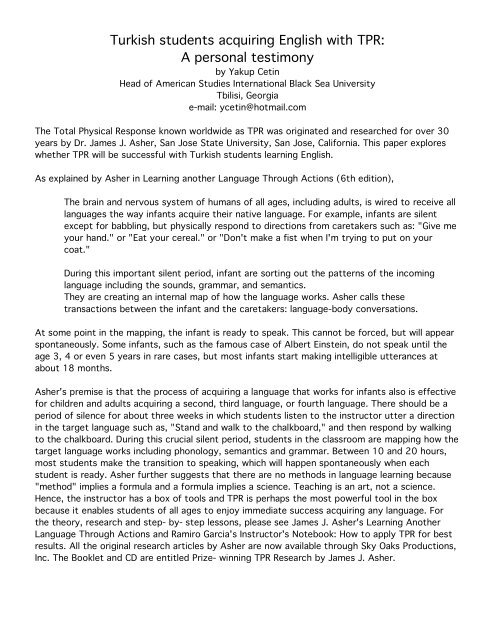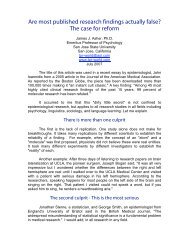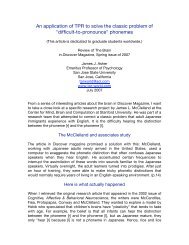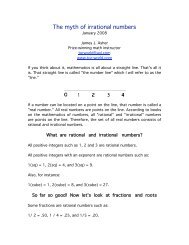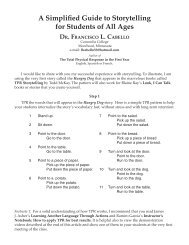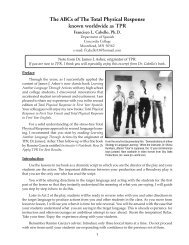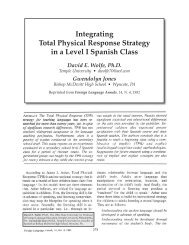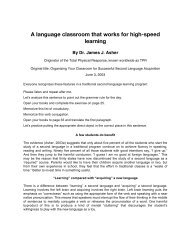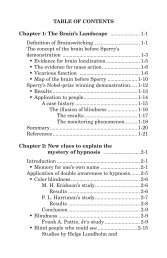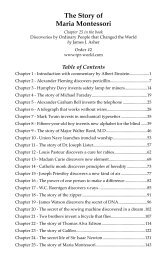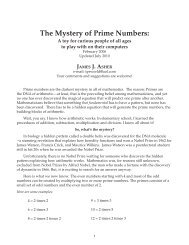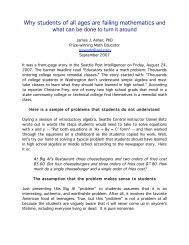Turkish students acquiring English with TPR: A ... - TPR World
Turkish students acquiring English with TPR: A ... - TPR World
Turkish students acquiring English with TPR: A ... - TPR World
You also want an ePaper? Increase the reach of your titles
YUMPU automatically turns print PDFs into web optimized ePapers that Google loves.
<strong>Turkish</strong> <strong>students</strong> <strong>acquiring</strong> <strong>English</strong> <strong>with</strong> <strong>TPR</strong>:<br />
A personal testimony<br />
by Yakup Cetin<br />
Head of American Studies International Black Sea University<br />
Tbilisi, Georgia<br />
e-mail: ycetin@hotmail.com<br />
The Total Physical Response known worldwide as <strong>TPR</strong> was originated and researched for over 30<br />
years by Dr. James J. Asher, San Jose State University, San Jose, California. This paper explores<br />
whether <strong>TPR</strong> will be successful <strong>with</strong> <strong>Turkish</strong> <strong>students</strong> learning <strong>English</strong>.<br />
As explained by Asher in Learning another Language Through Actions (6th edition),<br />
The brain and nervous system of humans of all ages, including adults, is wired to receive all<br />
languages the way infants acquire their native language. For example, infants are silent<br />
except for babbling, but physically respond to directions from caretakers such as: "Give me<br />
your hand." or "Eat your cereal." or "Don't make a fist when I'm trying to put on your<br />
coat."<br />
During this important silent period, infant are sorting out the patterns of the incoming<br />
language including the sounds, grammar, and semantics.<br />
They are creating an internal map of how the language works. Asher calls these<br />
transactions between the infant and the caretakers: language-body conversations.<br />
At some point in the mapping, the infant is ready to speak. This cannot be forced, but will appear<br />
spontaneously. Some infants, such as the famous case of Albert Einstein, do not speak until the<br />
age 3, 4 or even 5 years in rare cases, but most infants start making intelligible utterances at<br />
about 18 months.<br />
Asher's premise is that the process of <strong>acquiring</strong> a language that works for infants also is effective<br />
for children and adults <strong>acquiring</strong> a second, third language, or fourth language. There should be a<br />
period of silence for about three weeks in which <strong>students</strong> listen to the instructor utter a direction<br />
in the target language such as, "Stand and walk to the chalkboard," and then respond by walking<br />
to the chalkboard. During this crucial silent period, <strong>students</strong> in the classroom are mapping how the<br />
target language works including phonology, semantics and grammar. Between 10 and 20 hours,<br />
most <strong>students</strong> make the transition to speaking, which will happen spontaneously when each<br />
student is ready. Asher further suggests that there are no methods in language learning because<br />
"method" implies a formula and a formula implies a science. Teaching is an art, not a science.<br />
Hence, the instructor has a box of tools and <strong>TPR</strong> is perhaps the most powerful tool in the box<br />
because it enables <strong>students</strong> of all ages to enjoy immediate success <strong>acquiring</strong> any language. For<br />
the theory, research and step- by- step lessons, please see James J. Asher's Learning Another<br />
Language Through Actions and Ramiro Garcia's Instructor's Notebook: How to apply <strong>TPR</strong> for best<br />
results. All the original research articles by Asher are now available through Sky Oaks Productions,<br />
Inc. The Booklet and CD are entitled Prize- winning <strong>TPR</strong> Research by James J. Asher.
The <strong>Turkish</strong> culture: Will it block learning <strong>with</strong> <strong>TPR</strong>?<br />
I was apprehensive about the effectiveness of <strong>TPR</strong> in Turkey because of certain features in <strong>Turkish</strong><br />
culture:<br />
Teacher-centered classroom<br />
The <strong>Turkish</strong> educational system is mostly teacher- oriented. (Hesabcioglu, 1994). The teacher<br />
dominates the classroom; <strong>students</strong> respond only when they are asked. Traditionally, they are not<br />
encouraged to initiate a discussion or present a question, especially if the question is about a<br />
statement made by the teacher. Most of the time it is the teacher who talks in the classroom.<br />
What the teacher writes on the chalkboard is copied instantly. It is common for <strong>students</strong> to be<br />
silent in the classroom, while the teacher speaks. Students are generally passive listeners.<br />
The reverence for book learning<br />
It is an understatement to say that there is an emphasis on book learning. In the <strong>Turkish</strong> culture,<br />
there is something almost "sacred" about book learning. This means that high value is placed on<br />
memorizing the contents of a book because it is assumed that books are the keys to the "good<br />
life." Practical applications of what is being learned is incidental. There seems to be a need to<br />
distinguish the learning acquired by a person educated <strong>with</strong>in the formal system of the schools<br />
and the wisdom of a person on the street. Since it is not easy in Turkey to get into a formal<br />
educational system, this experience is given higher value than common sense or practical<br />
intelligence.<br />
Learning another language<br />
There is a strong belief that the optimal and only way to learn another language such as <strong>English</strong> is<br />
to memorize grammar rules and vocabulary from a book. How much this will block the successful<br />
application of <strong>TPR</strong> in the classroom was an unknown factor to me. <strong>Turkish</strong> attitudes that should<br />
enable learning <strong>with</strong> <strong>TPR</strong><br />
The importance of the group<br />
In the past, Turks have been strongly group-oriented. People tend to do things in groups whether<br />
it be the family, clan, or work team. Contrary to American culture, individualism is not encouraged<br />
or rewarded. However, this is one aspect of <strong>Turkish</strong> culture that may be changing because people<br />
are leaving the compact organization of the village and moving to the city. Life in the city makes<br />
for greater individualism and competitiveness rather than cooperation.<br />
Saving face<br />
In all cultures, but especially in the <strong>Turkish</strong> culture, it is important to maintain a good image of<br />
oneself before others. At all cost, one must avoid "loss of face" which is to forfeit the positive<br />
regard of others. Thus, demeaning or humiliating someone before others is an unforgivable insult;<br />
likewise, one should be careful not to get into situations where one could lose status or be<br />
humiliated. It is critical that language teachers be aware of this in their interaction <strong>with</strong> <strong>students</strong>.
Student attitude towards the instructor<br />
<strong>Turkish</strong> <strong>students</strong> have a very high regard for the teacher. The teacher is a model to imitate<br />
in terms of behavior and even appearance. (Bursalioglu, 1994). What teachers do should be<br />
emulated because they are the educated ones in this society, and education is very highly valued.<br />
(Hesabcioglu, 1994).<br />
Implications for language learning when adults are the <strong>students</strong><br />
Especially for adults, one risks a "loss of face" if there is pressure to make strange utterances in<br />
an alien language. Since one is almost certain to make mistakes if the instructor demands speaking<br />
on cue, <strong>students</strong> are often traumatized in a traditional language classroom. It is difficult to believe<br />
that any adult would continue to attend the traditional language class where almost from the first<br />
meeting, one must produce alien utterances on cue. <strong>TPR</strong> should be ideal for <strong>students</strong> of all ages<br />
since the risk of "losing face" is zero. The class is risk-free because there is no demand from the<br />
instructor to produce utterances in the target language.<br />
Turks are a kinesthetic people<br />
Turkey is a high contact culture. People like to touch each other, according to the situation and<br />
relationship involved (Kosay, 1944). They use their hands, and bodies in various forms of nonverbal<br />
communication. This could be an advantage since <strong>TPR</strong> is unique for language-body<br />
conversation. Someone gives a direction in the target language and someone else responds (i.e.,<br />
"If I pick up a book from my desk, run to the chalkboard and write your name.")<br />
A strong oral tradition<br />
<strong>Turkish</strong> people have a long tradition of listening to stories that are said or read aloud. This could<br />
work to my advantage since one way to make a transition from listening comprehension <strong>with</strong> <strong>TPR</strong><br />
to speaking, reading and writing is story telling. In the references, see the books by Todd Mc Kay<br />
and Blaine Ray.<br />
Summary<br />
I hypothesize that James Asher's Total Physical Response or <strong>TPR</strong> will be a successful tool <strong>with</strong><br />
<strong>Turkish</strong> language learners of all ages because of (a) the strong group ethos of working together,<br />
(b), the kinesthetic orientation of touching, and (c) the importance of never "loosing face" since<br />
there is no demand to produce alien utterances on cue from the teacher. Other factors in <strong>Turkish</strong><br />
culture are also compatible <strong>with</strong> <strong>TPR</strong> such as the traditional respect given to the teacher who is an<br />
authority figure. Hence, <strong>students</strong> are apt to cooperate <strong>with</strong> novel behavior when the instructor<br />
asks <strong>students</strong> to be silent and act quickly when given as direction in the target language.<br />
I was apprehensive that some other features in the <strong>Turkish</strong> school culture might seriously block<br />
learning any <strong>English</strong> <strong>with</strong> <strong>TPR</strong>. For example, <strong>students</strong> expect to read from a book, copy on paper,<br />
and memorize whatever the instructor says to memorize. Now <strong>with</strong> <strong>TPR</strong>, the "comfort zone" of<br />
the student will be removed and replaced <strong>with</strong> a new role for the instructor and the student. Will it<br />
work? Would there be insurmountable issues that I must cope <strong>with</strong> in planning any lesson. I was<br />
frankly anxious.
The results: Here is what I actually discovered<br />
I applied <strong>TPR</strong> <strong>with</strong> <strong>students</strong> between the ages of 11 and 16 in a private school. Twelve hours of<br />
each week was used for <strong>TPR</strong>. I used <strong>TPR</strong> to prepare <strong>students</strong> before they ever opened a book.<br />
In preparation for the first <strong>TPR</strong> lesson, I told the <strong>students</strong> that they were going to learn <strong>English</strong> in<br />
a way different from language education in other schools. They would be learning <strong>English</strong> in a way<br />
that was similar to how they learned <strong>Turkish</strong>. I made it clear to them that they were not expected<br />
to speak at the early stages. (Dr. James C. Davidheiser who uses <strong>TPR</strong> to teach German in an<br />
American high school successfully orients his <strong>students</strong> by showing a video demonstration of<br />
<strong>students</strong> between the ages of 17 and 60 <strong>acquiring</strong> German <strong>with</strong> <strong>TPR</strong>. The title is: Strategy for<br />
Second Language Learning." Students are excited to see that at the end of the course they will<br />
actually be conversing in German.)<br />
The first stage in my <strong>Turkish</strong> experiment<br />
In the first stage, I asked my <strong>students</strong> to observe me while I gave myself a command in<br />
<strong>English</strong> and then acted it out. The <strong>students</strong> listened and watched as I uttered one <strong>English</strong><br />
direction after another such as: Stand, Sit. Stand. Walk. Stop. Turn. Walk. Stop. Walk.<br />
Turn, and Sit. I spoke slowly and distinctly.<br />
The second stage<br />
The classroom was big and crowded, so for the second stage; I called some volunteers to the<br />
front of the class. This time I gave the commands and the volunteers acted them out. The rest of<br />
the class just listened and watched the performance. Students at their desks looked curious as<br />
they watched in silence.<br />
The third stage<br />
In the third stage, I sent the volunteers back to their seats and asked the whole class to act out<br />
many commands from where they were seated. This is possible once you expand one word<br />
utterances into more complex patterns such as:<br />
Point to the ceiling Point to the floor. Point to the chalkboard. Point to your desk. Point to the<br />
desk of a classmate. Touch your desk. Touch the desk of a classmate. Touch your head. Hold up<br />
your pencil. Put down the pencil and hold up a book. Put down the book and hold up a piece of<br />
paper. Put down the paper; pick up the pencil in your left hand and the book in your right hand.<br />
After some practice, I felt that the <strong>students</strong> were ready to act out the commands individually, so I<br />
asked for a volunteer. The volunteer came to the front of the class and responded perfectly to<br />
the commands. I was amazed that the <strong>students</strong> were not only understanding <strong>English</strong> in a brief<br />
time, but also enjoying the lesson. I was delighted that every time I asked for a new volunteer<br />
more hands went up. Here is the unexpected bonus: The <strong>students</strong> had fun because they were<br />
physically involved. I knew they understood because they acted out the commands correctly. The<br />
<strong>students</strong> were relaxed because they were not expected to talk unless they felt ready to talk. (As<br />
an aside, Asher and Garcia recommend that you invite two or more <strong>students</strong> to perform rather<br />
than just one student. The reason: Students seem to feel that there is "safety in numbers." They<br />
are apt to be more comfortable performing <strong>with</strong> the company of other <strong>students</strong>.)
Motivation was high<br />
Motivation was extraordinarily high. Students competed to demonstrate their comprehension. At<br />
the end of each lesson I wrote the commands and the vocabulary on the chalkboard. Students<br />
seemed contented as they copied the information in their notebooks. They seemed to enjoy being<br />
able to write the now familiar <strong>English</strong> utterances in their notebooks. This was a definite "hit."<br />
And now here is an unexpected bonus<br />
After each lesson, I looked out the window to the playground and saw the children giving each<br />
other the commands in <strong>English</strong> and having fun acting them out. This transfer of learning from the<br />
boundaries of the classroom to the playground was something one does not see from <strong>students</strong> in<br />
a traditional language class. The sight would "warm any instructor's heart."<br />
How long they retained the information<br />
My <strong>students</strong> continually demonstrated long-term retention because every week I was able to<br />
expand directions into a long, complex sequence that <strong>students</strong> could act out at their seats such<br />
as this: You are writing a letter <strong>with</strong> your pencil, but it is not writing very well. Look at the point of<br />
your pencil. Feel it <strong>with</strong> your thumb. Pick up your pencil case and open it. Take out your pencil<br />
sharpener. Hold the pencil sharpener in one hand and the pencil in the other hand. Put the pencil<br />
into the pencil sharpener. Sharpen the pencil by turning it. Take the pencil out and feel its point.<br />
Clean the pencil sharpener. Put the pencil sharpener into the pencil case and close it. Pick up the<br />
pencil and write.<br />
Here are some other <strong>TPR</strong> activities that my <strong>students</strong> were able to perform from their seats:<br />
Eating different kinds of fruits.<br />
Taking a medicine.<br />
Wrapping a gift.<br />
Sewing on a button.<br />
Receiving a present.<br />
Writing a letter.<br />
Painting a picture.<br />
Your imagination can expand the list of <strong>TPR</strong> activities in any direction. It all seems to work.<br />
They understand. But, of course, you must be patient and act out one component at a time and<br />
then put the entire sequence together.
Another effective tool that works while <strong>students</strong> are seated<br />
I found that my <strong>students</strong> had fun working <strong>with</strong> the <strong>TPR</strong> Student Kits. I held up my kit, spoke an<br />
<strong>English</strong> direction such as "Put the boy in the bedroom <strong>with</strong> the blue walls." Students observed me<br />
and performed the same action in their kits. It is amazing how you can reorganize components to<br />
create novel sentences (ones they have never heard before) and <strong>students</strong> instantly understand. I<br />
believe this is the real test of fluency that the linguist, Noam Chomsky, talked about. Fluency is<br />
being able to understand (and later produce in speaking, reading, and writing) an unlimited number<br />
of sentences in the target language.<br />
An application of <strong>TPR</strong> to <strong>Turkish</strong> Airlines<br />
<strong>TPR</strong> was an important component of a language program implemented at <strong>Turkish</strong> Airlines <strong>with</strong> a<br />
total of about 2,000 adult <strong>students</strong>. <strong>TPR</strong> was an exciting tool used in conjunction <strong>with</strong> other tools<br />
suggested in the books by James Asher and Ramiro Garcia. These included role-playing, skits<br />
which <strong>students</strong> created, wrote out in <strong>English</strong> and performed <strong>with</strong> other <strong>students</strong>, and games. The<br />
program also included ideas from suggestopaedia by Dr. Georgi Lozanov of Bulgaria. As you know,<br />
any successful instructor has a large box of tools to work <strong>with</strong> including traditional dialogues,<br />
patterned drills, and even at a more advanced stage of "polishing" the target language-- verb<br />
conjugation. It all fits together, but each tool plays to a different hemisphere of the student's<br />
brain at different points in the educational experience. For more on teaching and brain laterality,<br />
see the references for Asher's Brainswitching: Learning on the right side of the brain and The<br />
Super School: Teaching on the right side of the brain.<br />
Impressions from one instructor training employees at <strong>Turkish</strong> Airline<br />
I interviewed one of the instructors for <strong>Turkish</strong> Airline's language program who was a Canadian<br />
instructing 800 airline employees. The teacher noted the following about <strong>TPR</strong>: <strong>TPR</strong> sets up a huge<br />
"comfort zone" that adult <strong>students</strong> appreciate.<br />
Here are some of the reasons:<br />
First, the teacher "broke the ice" by demonstrating <strong>with</strong> herself playing the role of the student.<br />
She listened to herself utter a direction in <strong>English</strong> and then acted it out. She spoke slowly and<br />
distinctly. From her demonstration, it was clear exactly what the teacher expected of the<br />
<strong>students</strong>. Not only was it clear, but the "instructional ball was catchable," since it was obvious to<br />
everyone that, "Hey, I can do that." In a traditional language classroom there is always the fear<br />
(that escalates to terror for many <strong>students</strong>), "No, please don't call on me to repeat what you just<br />
said in that strange language. I can't do it! Please move on to someone else."<br />
Second, the procedure is new and interesting and risk-free since <strong>students</strong> were not expected to<br />
speak until each was ready. In a traditional language class, <strong>students</strong> are expected to speak on cue,<br />
often immediately, <strong>with</strong>out the opportunity to prepare through<br />
<strong>TPR</strong>. Third, <strong>students</strong> were surprised to realize that they were learning, even though they were not<br />
reading from a book or copying from the board. It was truly a revelation.<br />
Fourth, day after day, the student's comfort zone was expanded since they performed in groups<br />
rather than standing alone in front of the class. All of these factors combined to produce an<br />
enjoyable, exciting and successful learning experience for both the teacher and the adult <strong>students</strong>.
The initial response of the adult <strong>students</strong> to <strong>TPR</strong><br />
It was amusement and curiosity. They became more and more enthusiastic fans as they<br />
experienced praise by the teacher and other <strong>students</strong> <strong>with</strong> clapping and comments of "very<br />
good," or "great" even when they were not yet speaking the language. They seemed to be<br />
surprised that comprehension was rewarded. Once they became aware of how <strong>TPR</strong> works, they<br />
literally fought <strong>with</strong> each other for the chance to show that they understood what was being said.<br />
Some other tips from the Canadian instructor<br />
She discovered that she had to demonstrate the procedure very clearly, so that the meaning of<br />
the <strong>English</strong> was immediately understood. The demonstration had to show clearly what each<br />
student was expected to do. There was no ambiguity.<br />
Don't hesitate to be playful<br />
<strong>Turkish</strong> teachers are sometimes hesitant to relax a strict demeanor, but she found that a playful<br />
attitude encouraged <strong>students</strong> to relax and feel free to play <strong>with</strong> the target language like a toy<br />
rather than cower from it as if it was a fearful, menacing monster.<br />
How much reward is too much<br />
She praised every time a student did the smallest thing <strong>with</strong> success because she wanted to give<br />
the message that comprehension is important. Comprehension is absolutely basic preparation for<br />
speaking, reading, and writing. When <strong>students</strong> made mistakes, they were very gently shown the<br />
right response, so they did not feel embarrassed or shamed.<br />
Reward and celebration for small achievements by employees is the formula for success of Jack<br />
Welsh, world famous CEO of an American company, General Electric. Jack is fond of saying that,<br />
"It is the little things that count. Those small victories need to be applauded."<br />
Grand conclusions<br />
There are many language programs in Turkey today. More and more language programs start<br />
every year. For these programs, a variety of language "methods" are used. It is my observation,<br />
however, that schools and programs tend to adopt certain "methodologies" and texts <strong>with</strong>out<br />
giving much thought to whether the "methodologies" and texts are appropriate, given the cultural<br />
and social context of <strong>Turkish</strong> language learners.<br />
As a language teacher I have experimented <strong>with</strong> various "methodologies," and I conclude that the<br />
most powerful tool in my box of tools is <strong>TPR</strong>. In this paper, I developed a hypothesis regarding<br />
<strong>TPR</strong>, <strong>with</strong> special attention given to the culture of <strong>Turkish</strong> learners.<br />
My personal recommendations<br />
I discovered that <strong>TPR</strong> can be successfully used <strong>with</strong> <strong>Turkish</strong> learners, provided, in my opinion,<br />
certain conditions are met.
Start <strong>with</strong> a thorough understanding of the theory and application of <strong>TPR</strong><br />
You can acquire this by reading James J. Asher's Learning Another Language Through Actions<br />
(6th edition) and Ramiro Garcia's Instructor's Notebook: How to apply <strong>TPR</strong> for best results (4th<br />
edition).<br />
Extensive teacher training in the application of <strong>TPR</strong><br />
<strong>TPR</strong> looks simple, but to be effective, an instructor needs training, training and more training. The<br />
ideal would be to have an experienced <strong>TPR</strong> instructor as a mentor in the classroom to guide the<br />
new instructor step-by-step for many meetings until there is self-confidence and a huge comfort<br />
zone.<br />
It may help to adapt <strong>TPR</strong> to the local culture<br />
Right now, for example, we see many programs using materials, especially text books, that have<br />
very little cultural relevance to <strong>Turkish</strong> <strong>students</strong>. Because these texts follow a teaching approach<br />
that is fashionable, like the communicative approach, teachers and administrators use these books<br />
<strong>with</strong>out question. They think that because it follows a certain "methodology" that is popular, a<br />
book must be good.<br />
My <strong>students</strong> loved manipulating the <strong>TPR</strong> Student Kits<br />
I found that the kits were effective even if two or three <strong>students</strong> gathered together and worked<br />
<strong>with</strong> a kit as they listened to me utter directions in <strong>English</strong>. They later told me that they felt they<br />
were just playing a game but they were actually learning, learning, learning.<br />
No one demanded to see the <strong>English</strong> directions in print<br />
Even when the <strong>TPR</strong> was not accompanied by a student book, my <strong>students</strong> adjusted very easily to<br />
non-book learning. Students are more flexible than we imagine. In fact, the picture of <strong>students</strong><br />
being prisoners of a "heavy-handed" <strong>Turkish</strong> culture may turn out to be a myth like the myth that<br />
Japanese <strong>students</strong> are too shy to perform in public or Chinese <strong>students</strong> are unshakable in their<br />
belief that they must pronounce every <strong>English</strong> utterance before performing. I suspect that when<br />
<strong>students</strong> in any culture feel safe and trust the instructor, they are enabled to be playful. Please<br />
note that there is a huge difference between being playful and being disruptive. Playfulness under<br />
the guidance of a skilled teacher is productive, but disruptive behavior is counterproductive.<br />
<strong>TPR</strong> has more and more fans in Turkey because it works!<br />
REFERENCES<br />
Akansel, M. H. 1943. Turk’un Kitabi. Kenan Matbaasi: Istanbul.<br />
Asher, James J. Learning Another Language through Actions (6th edition): Los Gatos,<br />
California: Sky Oaks Productions, Inc.<br />
Asher, James J. Brainswitching: Learning on the right side of the brain Los Gatos,<br />
California: Sky Oaks Productions, Inc.
Asher, James J. The Super School: Teaching on the right side of the brain. Los Gatos,<br />
California: Sky Oaks Productions, Inc.<br />
Asher, James J. <strong>TPR</strong> Student Kits. (Available in <strong>English</strong>, Spanish, French, German or<br />
Dutch.) Los Gatos, California: Sky Oaks Productions, Inc.<br />
Asher, James J. <strong>TPR</strong> Teacher Kits. (Available in <strong>English</strong>, Spanish, French, German or<br />
Dutch.) Los Gatos, California: Sky Oaks Productions, Inc.<br />
Asher, James J. The Weird and Wonderful <strong>World</strong> of Mathematical Mysteries:<br />
Conversations <strong>with</strong> famous scientists and mathematicians. Los Gatos, California: Sky<br />
Oaks Productions, Inc.<br />
Asher, James J. A Simplified Guide ot Statistics for Non- Mathematicians: How to organize<br />
a successful research prohect. Los Gatos, California: Sky Oaks Productions, Inc.<br />
Asher, James J. Brainstorming Kit: the most powerful tool ever discovered for solving<br />
problems. Los Gatos, California: Sky Oaks Productions, Inc.<br />
Asher, James J. Prize-winning <strong>TPR</strong> Research. Booklet and CD <strong>with</strong> original research<br />
articles. Los Gatos, California: Sky Oaks Production.<br />
Asher, James J. Children Learning another Language: An innovative approach.- <strong>TPR</strong><br />
video demonstration of children from K through 6th Los Gatos, California: Sky Oaks<br />
Productions, Inc.<br />
Asher, James Motivational Strategy for Language Learning .-<strong>TPR</strong> video demonstration of<br />
<strong>students</strong> between the ages of 17 and 60 <strong>acquiring</strong> Spanish. Los Gatos, California: Sky<br />
Oaks Productions, Inc.<br />
Asher, James J. Strategy for Second Language Learning.-<strong>TPR</strong> video demonstration of<br />
student between the ages of 17 and 60 <strong>acquiring</strong> German Los Gatos, California: Sky Oaks<br />
Productions, Inc.<br />
Asher, James J. Demonstration of a New Strategy in Language Learning -<strong>TPR</strong><br />
demonstration of 12 year-old American children <strong>acquiring</strong> Japanese. Los Gatos,<br />
California: Sky Oaks Productions, Inc.<br />
Bursalioglu, Z. 1994. Okul Yonetiminde Yeni Yapi ve Davranis. Pegem: Ankara.<br />
Cabello, Francisco. <strong>TPR</strong> in First Year <strong>English</strong> (Also available in Spanish and French). Los<br />
Gatos, California: Sky Oaks Productions, Inc.<br />
Christopherson, Joan A Second Language Classroom that Works Los Gatos, California:<br />
Sky Oaks Productions, Inc.<br />
Erdentug, N. 1972. Turkiye Turk Toplumlarinda Kulturel Antropolojik<br />
Garcia, Ramiro. Instructor's Notebook: How to apply <strong>TPR</strong> for best results. Los Gatos,<br />
California: Sky Oaks Productions, Inc.
Garcia, Ramiro. Instructor's Notebook:<strong>TPR</strong> Homework Exercises Los Gatos, California:<br />
Sky Oaks Productions, Inc.<br />
Garcia, Ramiro. <strong>TPR</strong> Bingo (Available in Englihs, Spanish, French or German). Los Gatos,<br />
California, Sky Oask Productions, Inc.<br />
Garnett, L. M. J. 1934. The <strong>Turkish</strong> People. Methuen and Co.: London.<br />
Hesabcioglu, M. 1994. Ogretim Ilke ve Yontemleri: Egitim Programlari ve.<br />
Incelemeler. Ankara Universitesi Egitim Fakultesi Yayinlari: Ankara.<br />
Kosay, H. Z. 1944. Turk Dugunleri. Maarif Matbaasi: Ankara.<br />
Krashen, S. D. 1982. Principles and Practice in Second Language Acquisition. Oxford:<br />
Pergamon.<br />
Krashen, S. D. and Terrel, T. 1983. The Natural Approach. Oxford: Pergamon.<br />
Larsen-Freeman, D. 1986. Techniques and Practices in Language Teaching. New York:<br />
Oxford University Press.<br />
Marquez, Nancy. Learning With Movements (Available in <strong>English</strong>, Spanish, or French) Los<br />
Gatos, California: Sky Oaks Productions, Inc.<br />
McKay, Todd. <strong>TPR</strong>S Storytelling: Especially for <strong>students</strong> in elementary and middle school.<br />
(Available in <strong>English</strong>, Spanish or French) Los Gatos, California: Sky Oaks Productions,<br />
Inc.<br />
Ogretim: Beta Yayinlari. Istanbul.<br />
Olliphant, Joa Ann. Total Physical Fun. Los Gatos, California: Sky Oaks Productions, Inc.<br />
Palmer, H. E. And Palmer, D. 1970. <strong>English</strong> through Actions. London: Longman.<br />
Ray, Blaine. Look, I Can Talk series (Available in <strong>English</strong>, Spanish, French, or German).<br />
Los Gatos, California: Sky Oaks Productions, Inc.<br />
Richards J. C. and Rodgers, T. S. 1986. Approaches and Methods in Language Teaching:<br />
A Description and Analysis. Cambridge : Cambridge University Press.<br />
Schessler, Eric. <strong>English</strong> Grammar Through Actions: How to <strong>TPR</strong> 50 grammatical features<br />
in <strong>English</strong> (Also available in Spanish and French). Los Gatos, California: Sky Oaks<br />
Productions, Inc.<br />
Seely, Contee and Elizabeth Romijn. <strong>TPR</strong> is More than Commands at all Levels. Los<br />
Gatos, California: Sky Oaks Productions, Inc.
Silvers, Stephen M. Listen and Perform series. (Available in <strong>English</strong>, Spanish, spanish or<br />
French) Los Gatos, California: Sky Oaks Productions, Inc.<br />
Silvers, Stephen M. The Command Book: How to <strong>TPR</strong> 2,000 vocabulary items in any<br />
language. Los Gatos, California: Sky Oaks Productions, Inc.<br />
Woodruff, Margaret S. Comprehension Based Language Lessons. Los Gatos, California:<br />
Sky Oaks Productions, Inc.<br />
Woodruff, Margaret S. and Laura J. Ayala. Favorite Games for Fl-ESL Classes. Los<br />
Gatos, California: Sky Oaks Productions, Inc.


